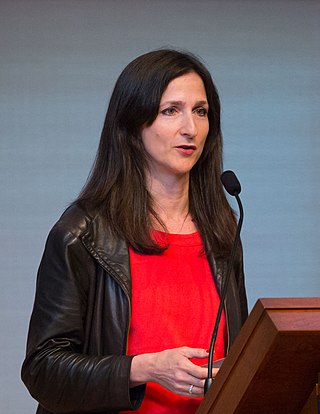
The American Astronomical Society is an American society of professional astronomers and other interested individuals, headquartered in Washington, DC. The primary objective of the AAS is to promote the advancement of astronomy and closely related branches of science, while the secondary purpose includes enhancing astronomy education and providing a political voice for its members through lobbying and grassroots activities. Its current mission is to enhance and share humanity's scientific understanding of the universe as a diverse and inclusive astronomical community.

Eleanor Margaret Burbidge, FRS (née Peachey; 12 August 1919 – 5 April 2020) was a British-American observational astronomer and astrophysicist. In the 1950s, she was one of the founders of stellar nucleosynthesis and was first author of the influential B2FH paper. During the 1960s and 1970s she worked on galaxy rotation curves and quasars, discovering the most distant astronomical object then known. In the 1980s and 1990s she helped develop and utilise the Faint Object Spectrograph on the Hubble Space Telescope. Burbidge was also well known for her work opposing discrimination against women in astronomy.
The Catherine Wolfe Bruce Gold Medal is awarded every year by the Astronomical Society of the Pacific for outstanding lifetime contributions to astronomy. It is named after Catherine Wolfe Bruce, an American patroness of astronomy, and was first awarded in 1898.
The American Association of Variable Star Observers (AAVSO) is an international nonprofit organization. Founded in 1911, the organization focuses on coordinating, analyzing, publishing, and archiving variable star observations made largely by amateur astronomers. The AAVSO creates records that establish light curves depicting the variation in brightness of a star over time. The AAVSO makes these records available to professional astronomers, researchers, and educators.

Halton Christian "Chip" Arp was an American astronomer. He is remembered for his 1966 book Atlas of Peculiar Galaxies, which catalogued unusual looking galaxies and presented their images.
The George Van Biesbroeck Prize is an award for long-term achievements in the field of astronomy. According to the American Astronomical Society awards website; "The Van Biesbroeck prize is normally awarded every two years and honors a living individual for long-term extraordinary or unselfish service to astronomy, often beyond the requirements of his or her paid position."

The NASA Distinguished Service Medal is the highest award that can be bestowed by the National Aeronautics and Space Administration of the United States. The medal may be presented to any member of the federal government, including both military astronauts and civilian employees.
The Dannie Heineman Prize for Astrophysics is jointly awarded each year by the American Astronomical Society and American Institute of Physics for outstanding work in astrophysics. It is funded by the Heineman Foundation in honour of Dannie Heineman.
The Brouwer Award is awarded annually by the Division on Dynamical Astronomy of the American Astronomical Society for outstanding lifetime achievement in the field of dynamical astronomy. The prize is named for Dirk Brouwer.

The NASA Exceptional Scientific Achievement Medal was established by NASA on September 15, 1961, when the original ESM was divided into three separate awards. Under its guidelines, the ESAM is awarded for unusually significant scientific contribution toward achievement of aeronautical or space exploration goals. This award may be given for individual efforts that have resulted in a contribution of fundamental importance in this field, or have significantly enhanced understanding of this field.

Sara Seager is a Canadian-American astronomer and planetary scientist. She is a professor at the Massachusetts Institute of Technology and is known for her work on extrasolar planets and their atmospheres. She is the author of two textbooks on these topics, and has been recognized for her research by Popular Science, Discover Magazine, Nature, and TIME Magazine. Seager was awarded a MacArthur Fellowship in 2013 citing her theoretical work on detecting chemical signatures on exoplanet atmospheres and developing low-cost space observatories to observe planetary transits.
The Corday–Morgan Medal and Prize is awarded by the Royal Society of Chemistry for the most meritorious contributions to experimental chemistry, including computer simulation. The prize was established by chemist Gilbert Morgan, who named it after his father Thomas Morgan and his mother Mary-Louise Corday. From the award's inception in 1949 until 1980 it was awarded by the Chemical Society. Up to three prizes are awarded annually.
The Beilby Medal and Prize is awarded annually to a scientist or engineer for work that has exceptional practical significance in chemical engineering, applied materials science, energy efficiency or a related field. The prize is jointly administered by the Institute of Materials, Minerals and Mining, the Royal Society of Chemistry and the Society of Chemical Industry, who make the award in rotation.

The 104th Massachusetts General Court, consisting of the Massachusetts Senate and the Massachusetts House of Representatives, met in 1883 during the governorship of Benjamin Butler. George Glover Crocker served as president of the Senate and George A. Marden served as speaker of the House.
James Wellington Truran Jr. was an American physicist, known for his research in nuclear astrophysics.






